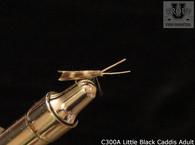
Classifying a body of flowing water by size is simple, for example, rivers by definition are large, creeks are smaller and feeder streams are smaller yet. However, further classification is often difficult because location, geology, chemistry, biological life, flow rate and a host of other physical and chemical characteristics are all different. Regardless of what we call them, each body of flowing water takes on the chemical characteristics of the dissolved portion of the substrate over which it flows, making the chemistry and the PH of each one unique.
However, some features are common to groups of similar cold, moving bodies of water. For example, some creeks or rivers begin as runoff from snow melting, or rain in the upper elevations, while another large group of streams begin as gentile springs that bubble up high in the mountains from the underground reservoirs, still others excellent fisheries are the result of impoundments that release tailwater.
When I started to get serious about fishing for trout I often heard the terms “Freestone” or “Spring Creek” or “Tailwaters” when referring to a particular stream. The term Spring Creek gave me the most wonderment; did that indicate that the stream existed only in the spring of the year? I am going to do some blogs that will discuss the definitions of these bodies of water, starting with Freestone.
The vast majority of the fresh cold, free flowing streams the world over are what is called freestone rivers. They start high in the mountains as a result of snow melting or rain falling and the little streamlets combine to make a feeder stream then a fishable creek and finally a larger a river such as the Yellowstone River. The term freestone originates from the fact that the water flows over gravel, rocks and rubble on the bed of the stream. This type of river bed is the result of erosion, landslides or avalanches. As the erosion takes place, the rocks become rounded and are reduced to freely moving, smooth stones, and gravel making them indeed “free stones”. The sized, composition, number, and shape of these stones as well as the gradient of the river and the local terrain determine the characteristics of that river.
As a result of the water being cold and constantly tumbling over these rocks, the water is highly oxygenated and the aquatic life forms are highly aerobic. Also, these freestone waters are usually acidic in nature due to the hemlocks, oak trees, acid rain, soil and other factors that influence the acidity. Finally, these rivers will lead to the seas or oceans. Most of the freestone rivers of the northern hemisphere support significant populations of trout.
The turbulent currents in freestone rivers provide ideal habitat for trout as well as the aquatic life that supports the trout’s appetite. Generally, the temperature of the freestone streams is cool and ideal for trout when they are still high in the mountains, but as the river flows farther and also gets wider, the temperature warms up until it can no longer support trout populations. In the summer due to the rapidly changing conditions in trout are often forced to seek out the cooler waters of spring holes, the mouths of feeder streams or migrate up the feeder streams making them vulnerable to predators. Many freestone trees are in an environment of hardwood trees that will provide some relief in the form of shade as well as providing a smorgasbord of terrestrial insects to help the trout survive the stressful conditions brought on by the warmer weather.
The acidity of the water is a definite factor in determining and preserving the quality of the water. Since the freestone streams start in the higher elevations, the leaves from the hardwood trees add acid to the streams, the substrate over which the water flows adds acid as does the acid snow melt. The acid can leach aluminum from the surrounding soils, which is very detrimental to the native brook trout. The buffering capacity of calcium and other metal ions in the rocks and soil can be depleted leaving the stream too acid. The acidity level of the stream greatly influences the type of aquatic life and consequently how you evaluate and how you fish these streams. For more about that please go to Trout University Advanced Class 427 Fishing Good Trout Streams vs. Poor Trout Streams and Advanced Class 4271 Fishing Fertile and Infertile Trout Streams.





